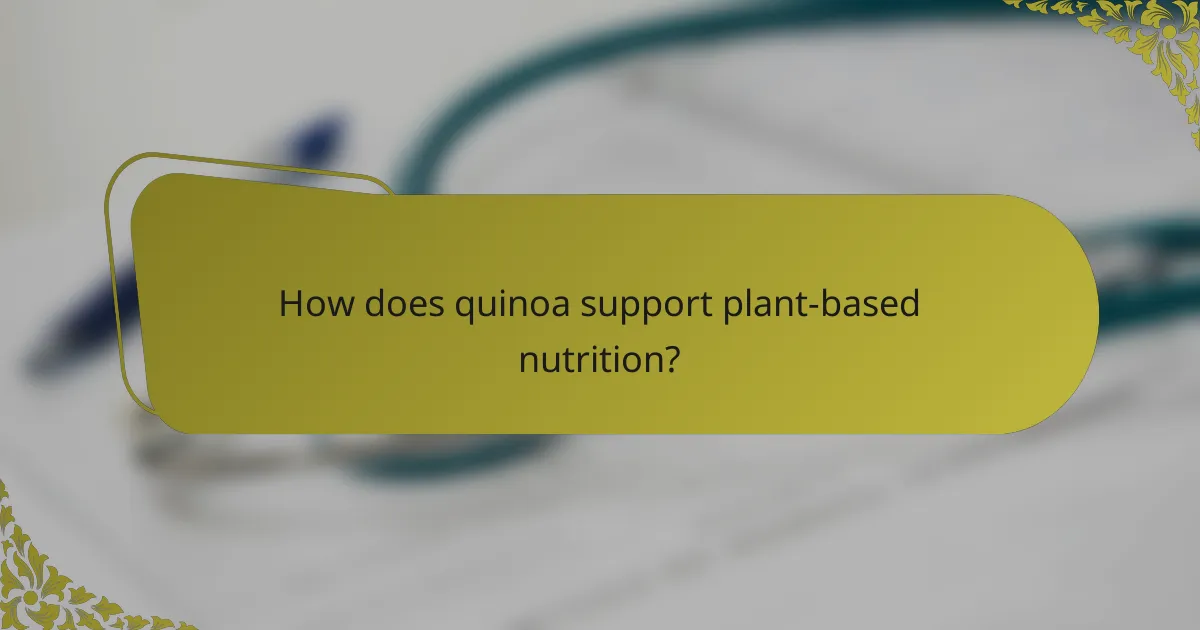Quinoa is an excellent choice for those seeking nutritious options in gluten-free diets and plant-based nutrition. It provides high protein content and essential amino acids. Quinoa is rich in fibre, vitamins, and minerals, promoting digestive health and nutrient absorption. Its versatility allows for easy incorporation into meals, enhancing dietary diversity and overall nutrient intake.

What are the nutritional advantages of quinoa for gluten-free diets?
Quinoa offers significant nutritional advantages for gluten-free diets, including high protein content and essential amino acids. It is rich in fibre, promoting digestive health, and contains vital minerals like magnesium and iron. Quinoa is also a source of antioxidants, which can reduce inflammation. Its versatility allows easy incorporation into various meals, making it an excellent choice for plant-based nutrition.
How does quinoa compare to traditional gluten-containing grains?
Quinoa is a superior gluten-free alternative to traditional gluten-containing grains, offering higher protein and essential amino acids. Unlike wheat or barley, quinoa contains all nine essential amino acids, making it a complete protein source. Additionally, quinoa is rich in fibre, vitamins, and minerals, supporting overall health. Its low glycaemic index also benefits blood sugar management compared to many grains.
What essential vitamins and minerals are found in quinoa?
Quinoa is rich in essential vitamins and minerals, including magnesium, phosphorus, manganese, and B vitamins. These nutrients support overall health, making quinoa a valuable addition to gluten-free and plant-based diets. Magnesium aids in muscle function, while phosphorus is crucial for bone health. Manganese contributes to antioxidant defenses, and B vitamins play a role in energy metabolism.
Why is quinoa considered a complete protein source?
Quinoa is considered a complete protein source because it contains all nine essential amino acids. This makes it particularly valuable for gluten-free diets and plant-based nutrition. Quinoa provides approximately 8 grams of protein per cooked cup, making it a significant protein source compared to other grains. Its unique amino acid profile supports muscle repair and growth, which is crucial for those following vegetarian or vegan diets. Additionally, quinoa is rich in fibre, vitamins, and minerals, enhancing its nutritional benefits.

How does quinoa support plant-based nutrition?
Quinoa supports plant-based nutrition by providing essential nutrients and a complete protein source. It contains all nine essential amino acids, making it a rare plant-based protein. Quinoa is also rich in fibre, vitamins, and minerals, promoting digestive health and nutrient absorption. Its gluten-free nature makes it suitable for individuals with gluten sensitivities, enhancing dietary diversity. Incorporating quinoa into meals can improve overall nutrient intake and support a balanced, plant-based diet.
Which recipes highlight quinoa’s versatility in plant-based meals?
Quinoa’s versatility in plant-based meals shines through its adaptability in various recipes. It can be used in salads, soups, stir-fries, and as a grain substitute in dishes like burgers and casseroles.
1. Quinoa Salad: Combine cooked quinoa with fresh vegetables, herbs, and a lemon vinaigrette for a nutritious meal.
2. Quinoa Stir-Fry: Use quinoa as a base and stir-fry with tofu and seasonal vegetables for a protein-packed dish.
3. Quinoa Soup: Add quinoa to vegetable broth with beans and spices for a hearty soup.
4. Quinoa Burgers: Blend cooked quinoa with beans, spices, and breadcrumbs to form patties for a delicious burger.
5. Quinoa Casserole: Layer quinoa with vegetables and a creamy sauce for a comforting baked dish.
6. Quinoa Breakfast Bowl: Serve quinoa with fruits, nuts, and a drizzle of honey for a healthy breakfast option.
These recipes highlight quinoa’s nutritional benefits and its ability to enhance flavour and texture in plant-based diets.
How can quinoa enhance the nutritional profile of vegan dishes?
Quinoa significantly enhances the nutritional profile of vegan dishes by providing essential amino acids, fibre, and micronutrients. It is a complete protein, containing all nine essential amino acids, which is rare among plant foods. This makes quinoa an excellent choice for vegans seeking to meet their protein needs. Additionally, quinoa is rich in magnesium, iron, and antioxidants, contributing to overall health. Its high fibre content supports digestive health and helps maintain satiety. Quinoa’s versatility allows it to be easily incorporated into various vegan recipes, enhancing both taste and nutrition.

What are the unique health benefits of quinoa for specific dietary needs?
Quinoa offers unique health benefits for individuals following gluten-free diets and plant-based nutrition. It is a complete protein, providing all nine essential amino acids, which is rare among plant foods. Quinoa is also high in fibre, aiding digestion and promoting satiety. Its low glycaemic index supports stable blood sugar levels, making it suitable for those managing diabetes. Additionally, quinoa contains essential minerals like magnesium and iron, which are often lacking in plant-based diets. These attributes position quinoa as a versatile and nutritious option for diverse dietary needs.
How can quinoa aid in weight management for gluten-free dieters?
Quinoa aids in weight management for gluten-free dieters by providing high protein and fibre content, promoting satiety. This whole grain is nutrient-dense and low in calories, making it an excellent choice for those seeking to control their weight. Quinoa’s unique amino acid profile supports muscle maintenance while its complex carbohydrates provide sustained energy. Additionally, it is gluten-free, making it a safe option for individuals with gluten sensitivities.
What role does quinoa play in managing blood sugar levels?
Quinoa helps manage blood sugar levels due to its low glycaemic index and high fibre content. This nutritious grain stabilises blood sugar by slowing digestion and promoting gradual glucose absorption. Quinoa is rich in protein and essential amino acids, making it a valuable addition to gluten-free diets and plant-based nutrition. Studies indicate that incorporating quinoa can improve insulin sensitivity, further aiding blood sugar management.

Which cooking methods maximize quinoa’s health benefits?
Cooking methods that maximize quinoa’s health benefits include steaming, boiling, and baking. These methods preserve nutrients and enhance digestibility. Steaming retains vitamins and minerals, while boiling can increase the absorption of amino acids. Baking quinoa in dishes allows for flavourful combinations that maintain its nutritional profile.
What are the best practices for preparing quinoa for optimal nutrition?
Soaking quinoa before cooking enhances its nutritional profile by removing saponins, which can cause bitterness. Rinsing quinoa thoroughly under cold water also improves flavour and digestibility. Cooking quinoa in a ratio of 2:1 water to quinoa ensures optimal texture and nutrient retention. For added nutrition, consider using vegetable broth instead of water. Incorporating spices like turmeric or cumin during cooking can enhance both flavour and health benefits.
How can quinoa be incorporated into everyday meals effectively?
Quinoa can be effectively incorporated into everyday meals by using it as a versatile ingredient in various dishes. This gluten-free grain serves as a nutritious base for salads, bowls, and side dishes.
Add cooked quinoa to salads for extra protein and fibre. Use it in grain bowls with vegetables and legumes to enhance plant-based nutrition. Quinoa can also replace rice or couscous in recipes, providing a unique texture and flavour.
Additionally, consider using quinoa in breakfast dishes, such as porridge or as a topping for yoghurt. Its high protein content makes it a great choice for those following gluten-free diets or plant-based nutrition.
Lastly, experiment with quinoa in baking, such as in muffins or energy bars, to boost nutritional value while enjoying its health benefits.

What are some common misconceptions about quinoa?
Many misconceptions about quinoa include its classification as a grain and its protein content. Quinoa is actually a seed, often mistaken for a grain due to its culinary uses. It is gluten-free, making it suitable for those with gluten intolerance. Additionally, quinoa is a complete protein, providing all nine essential amino acids, which is rare among plant foods. Some believe quinoa is overly processed, but many varieties are minimally processed and retain their nutritional benefits.
Why do some people experience digestive issues with quinoa?
Some people experience digestive issues with quinoa due to its high fibre content and the presence of saponins. These compounds can irritate the digestive system, leading to discomfort. Additionally, individuals with certain sensitivities may struggle to digest the proteins in quinoa, causing bloating or gas. Preparing quinoa properly, such as rinsing it before cooking, can help mitigate these issues.
How can individuals avoid potential allergies or sensitivities to quinoa?
Individuals can avoid potential allergies or sensitivities to quinoa by following specific precautions. First, choose certified gluten-free quinoa to prevent cross-contamination. Second, rinse quinoa thoroughly before cooking to remove saponins, which can cause digestive issues. Third, introduce quinoa gradually into the diet to monitor for any adverse reactions. Lastly, consider cooking quinoa well, as heat can reduce allergenic properties. These steps help ensure a safe and beneficial incorporation of quinoa into gluten-free and plant-based diets.

What tips can enhance the enjoyment and health benefits of quinoa?
To enhance the enjoyment and health benefits of quinoa, consider these tips. First, rinse quinoa thoroughly to remove saponins, which can impart a bitter taste. Next, toast quinoa in a dry pan before cooking to deepen its flavour. Additionally, cook quinoa in vegetable broth instead of water for added richness. Incorporate a variety of vegetables and herbs to boost nutritional content and flavour diversity. Finally, pair quinoa with sources of vitamin C, like bell peppers or citrus, to enhance iron absorption, making it even more beneficial for plant-based diets.
How can quinoa be paired with other foods for balanced meals?
Quinoa pairs well with various foods to create balanced meals. Combining quinoa with legumes, vegetables, nuts, and seeds enhances its protein content and nutrient profile. For example, a quinoa salad with black beans and bell peppers offers a rich source of fibre, vitamins, and minerals. Adding avocado provides healthy fats, while incorporating leafy greens boosts iron and calcium intake. This combination supports a gluten-free diet and aligns with plant-based nutrition principles, making meals more satisfying and nutritious.
What are the best storage practices for maintaining quinoa’s freshness?
To maintain quinoa’s freshness, store it in a cool, dry place in an airtight container. This prevents moisture and pests from affecting quality.
For optimal storage, consider these practices:
1. Keep quinoa in a dark cupboard or pantry away from sunlight.
2. Use glass or plastic containers with tight seals to avoid air exposure.
3. Refrigerate or freeze for long-term storage to extend shelf life.
4. Label containers with the purchase date to monitor freshness.
These methods help preserve quinoa’s nutritional benefits, making it a reliable choice for gluten-free diets and plant-based nutrition.
